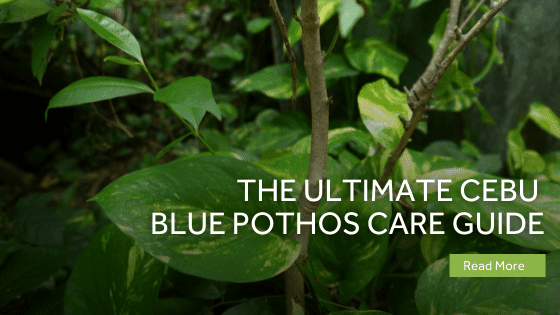My green-thumbed mom once told me that “to plant a tree or cultivate your garden is to believe in tomorrow.” The simply beautiful Cebu Blue Pothos reminds me of my mom’s love for trees and houseplants.
Hailing from the Queen City of the South, Cebu Island, the Philippines, this vibrant vine of the Epipremnum Pinnatum variety will sweetly steal your heart. From deep green to sparkling silvery-blue foliage, the Cebu Blue Pothos is a beauty worth caring for. Read our guide for everything you need to know about the marvelous Blue Pothos plant.
Table of Contents
Cebu Blue Overview
As the name suggests, the Blue Pothos comes from the beautiful island paradise of Cebu, which is also the oldest city and the first capital of the Philippines. This tropical evergreen perennial vine can climb up bigger trees and old walls from the old Spanish era. This vibrant vine is now rapidly spreading across the world, earning a well-deserved hot houseplant trend status!
Although mainly found in the Philippine Islands, the Cebu Blue Pothos can also be found in other tropical places in Asia, such as Taiwan and Japan, and Northern Australia. The Cebu Blue plant belongs to the Family of Araceae, specifically the Epipremnum Pinnatum species.
Other common names of Cebu Blue Pothos include the Devil’s Ivy, Centipede Tongavine, Blue Pothos, Schindapsus Aureum, Dragon-Tail Plant, Philodendron Cebu Blue Plant, and Tibatib in the Philippines.
| Botanical Name | Cebu Blue Pothos |
| Family | Araceae |
| Genus | Epipremnum |
| Origin | Cebu, Philippines |
| Sunlight | Bright indirect light |
| Watering | Once or twice a week |
| Soil | Well-draining soil |
| Temperature | 60°F to 90°F (16°C – 32°C) |
| Propagation | By stem cuttings |
| Re-Potting | Once a year |
| Pests and Diseases | Susceptible to common pests |
| Toxicity | Toxic to humans and animals |
Cebu Blue Features
Cebu Blue Pothos produces spectacular sparkling blue foliage. The Pothos plants are the easiest vines to cultivate indoor or outdoor, making this tropical variety perfect for beginners. In addition, this Cebuana beauty has an average lifespan of 20 years, so you can expect a longer time to enjoy its marvelous display of bluish leaves!
Growing in its natural habitat, the plant starts life with its delicate little lance-shaped blue leaves. They develop later on deep fenestrations or holes in the leaves when they mature later in life.
Height, size, spread
If grown outdoors, a mature Cebu Blue Pothos plant can reach up to 40 feet long with bigger luscious leaves. However, if grown indoors, this plant is not likely to reach no more than 10 feet in height, with bluish leaves no longer than 4 inches.
Leaves
The leaves of the Cebu Blue Pothos have a prominent bluish-gray color or silver shade. In addition, the foliage has different shades of green, or bluish-green, silver, and blue. These different shades look even more marvelous in bright light. The leaves are elongated or oval with 2 to 3 inches or more in length.
During its juvenile phase, the thin leaves have an oblong shape with a silverish blue hue. Once it reaches maturity, the leaves will transform into tiny greenish color zig-zag splits called fenestrations.
Toxicity
The Cebu Blue Pothos is toxic to humans and animals. Therefore, it is best to keep the plant away from kids and pets.
Deer and rabbit resistance
Due to the toxicity level that the Cebu Blue Pothos has, common grazers like deers and rabbits may stay away from this plant. But still, it is no guarantee that they will not try to munch on these luscious-looking tropical plants.
Cebu Blue Care Guide
Caring for Cebu Blue is pretty straightforward. This tropical plant will not demand too much from you. It is for this reason that I highly recommend this plant to novices in the world of houseplants. The Cebu Blue Pothos will give you years of enjoyment and fresher air with minimum care and attention.
This tropical plant will quite happily sit and grow once you have its Cebu Blue Pothos care requirements right.
Ideal Growing Place
The Cebu Blue Pothos can be grown outdoors or indoors. However, if you want to see the full potential of the marvelous display of this same plant, growing it in an outdoor garden is the way to go.
Given ideal growing conditions near its natural environment in the wild, this Pothos plant can grow as tall as 40 feet with gorgeous leaves that go through two growth stages and appearances. However, the height and size of leaves may not be as massive when this Pothos plant is grown indoors.
If you grow this plant in a hanging basket, its growth may be limited or stunted. The Cebu Blue Pothos plant loves to grow in the ground or inside a pot on the floor with something to climb on, like a trellis or moss totem pole.
Water
The Cebu Blue Pothos requires medium watering. This plant does not like too much watering. Otherwise, it will develop fungal or infection problems. Overwatering is a huge no-no. The ideal watering routine of this plant is once a week.
If you live in a dry location or during hotter days, you may water the plant twice a week or even more, depending on the plant’s need. Just be sure to keep its potting soil moist but not soggy or waterlogged. Take a few seconds to check the soil if you have it right.
Sunlight
Cebu Blue Pothos plants thrive best in an environment with bright, indirect light. It can tolerate and grow indoors with a medium-light or minimal light and shade.
You may place the pothos plants outside with a small amount of direct sunlight or shaded area. However, you have to avoid exposing the plant directly to sunlight. Direct sunlight will burn its leaves.
To ensure healthy plant growth, place the Cebu Blue Pothos in a shaded spot outside that mimics its natural habitat or near a window with a thin veil of coverage to protect it from direct sunlight. This will give the Pothos the chance to thrive and produce beautiful, blue foliage.
Temperature
The best temperature for the Cebu Blue Photos ranges from 60°F to 90°F (16°C – 32°C). This plant is not particularly picky when it comes to temperature. Just be sure not to expose it to extreme changes in temperature. Bring the plant inside during the colder months, at a safer distance away from windows and vents.
Soil
When it comes to potting mix, the Cebu Blue Pothos plant is not picky. Just be sure to use well-draining soil, and you are good to go. The biggest killer for this plant is excess water due to its planter being filled with soil that does not drain well.
If you want to encourage robust growth for this plant, a rich soil mixture with a good PH level is the key. I recommend around 6.1 to 7.8 pH balance. Go for a chunky potting mix that contains perlite, vermiculite, or orchid bark. This will ensure a well-draining soil but will still retain a healthy amount of moisture.
Like all tropical houseplants, their roots are susceptible to root rot. So you have to make sure to put them in a pot with drainage holes.
Humidity
The Cebu Blue Pothos plant will survive in normal humidity levels. But if you want your pothos plants to grow at their best, increasing the environment’s humidity level will achieve that optimal plant growth. For example, if you place it in a room with around 80% humidity, the plant will be one happy camper.
If the humidity level in your home is not ideal, you can provide some assistance to your Cebu Blue plants by misting them with a spray bottle from time to time. You may also install a humidifier for your houseplants. Or you can use a pebble tray. Grouping your houseplants can also help to increase the humidity level of their environment.
Fertilizer
Feeding the Cebu Blue Pothos with a little fertilizer during their juvenile phase will help accelerate their robust growth and development. You can either use a slow-release fertilizer or organic fertilizer. Both work very well. However, when using soluble fertilizer, diluting it to lessen its potency is advised.
The best time to feed the plan is during the spring and summer seasons when the plant is actively growing. Avoid feeding too much fertilizer to avoid burning its roots. During its dormancy period in the winter season, feeding is not necessary.
Pinching/Pruning
Since the Cebu Blue Pothos has healthy, strong growth, it is best to prune it back to make sure it looks great, encourage and control its healthier trailing growth. If left unchecked, the Pothos plants will look straggly and leggy. You may trim or prune the plant to climb in a specific direction.
Use disinfected scissors or shears when pruning to eliminate the risks of fungal infection. Remove or pinch dead leaves to conserve the energy of your houseplant and make it look at its best.
Potting and Re-potting
The Cebu Blue plants are fast-growing compared to other houseplants. They may easily outgrow their current pot and require repotting in a fresh soil mix. On average, repotting your Cebu Blue Pothos plants once a year is ideal. Schedule your repotting in the springtime to ensure faster recovery of the plant.
Transplant your Cebu Blues in a bigger pot with fresh nutrient-rich soil. If you intend to keep your Cebu Pothos small and longer juvenile phase, I suggest planting them in a hanging pot. This way, it does not have the usual support it needs to climb and grow bigger.
Growth Zone
The ideal USDA hardiness growth zones for the Cebu Blue Pothos range from 9 to 11.
Be sure to relocate your Cebu Blues to a warmer place if you live in a colder area. You may bring the plant outside during the summer. Conversely, protect the plant from the cold by bringing it back indoors when the temperature drops to freezing conditions.
Common Pests, Toxins, Diseases & Other Problems
Cebu Blue Pothos care is relatively easier than other plants. But the beautiful plant is susceptible to common pests that can jeopardize its health.
Make regular inspections on your plant for any presence of fungus gnats, mealybugs, aphids, scales, and spider mites. Check the leaves and crevices of your Pothos carefully. Use insecticidal soap or neem oil to get rid of the pests.
If some of the leaves of your Cebu Blue Pothos are yellowing, the usual reasons for this are underwatering and the lack of enough sunlight. When any of this happens, be sure to rectify the situation by giving the plant a good drink and making sure it gets enough bright indirect light to recover its health.
Moreover, if you see your plant’s leaves becoming crispy or browning, it means that it receives too much exposure to direct sunlight. Be sure to provide a shade for the plant so it will not get scorched from the sun’s heat.
Propagation
The Cebu Blue Pothos is one of the easiest plants to propagate. The most common method to multiply your Cebu Blues is by stem cuttings from the mother plant. Here is a step-by-step guide to propagating the blue Pothos:
- Use a sterilized or disinfected cutting blade to cut about 3 to 4 stems from a healthy mother plant. Each stem cutting should be about 7 to 10 inches long with at least one leaf.
- Be sure to cut below the nodes or aerial roots on the stem.
- Put the fresh stem cuttings in the water jar with the nodes submerged while keeping the rest of the stem cuttings out of the water.
- Place the jar in a spot where the freshly cut stems can get bright indirect sunlight.
- Change the water every 2 to 3 days and wait for the nodes to develop into roots.
- The waiting period is about 3 to 4 weeks for the tiny roots to develop into a proper root system.
- Once the roots grow to a couple of inches long, you can now transfer the plantlet to the potting soil.
Aside from water propagation, you can also plant the stem cuttings directly into moist soil. However, you will not see immediately if the propagation is successful until you see the shoots start to grow. So water propagation is a sure way to know if you have a successful propagation.
When doing direct soil propagation, always use a fresh pot filled with moist and well-drained soil.
Cebu Blue Mature Timeline
Week 1: This is the early days of the propagation period. During this period, the important thing to keep in mind is to provide healthy growing conditions for the Cebu Blue Photos to grow into a self-sufficient plant. Avoid direct sunlight and overwatering during this crucial period.
Week 2-3: If you are doing water propagation, keep changing the water every 2-3 days. If propagation is direct to the soil, maintain a moderate watering routine when the upper 2 inches of the soil get dry.
Week 4-6: The nodes of the stem cuttings should start to develop into a proper root system during this period. You may now transfer the water propagated plantlets to the soil as described above.
Week 12-24: Give the plantlets a good drink once or twice a week. Be sure the soil is properly moist without being soggy. During this period, the new Cebu Blue Pothos should start sprouting healthy foliage. You may now feed it a small amount of organic fertilizer.
Week 24-30: With the right Cebu Blue Pothos care, your tropical trailing plant at this time will display gorgeous, sparkling blue foliage. You can start to treat it like you do for mature plants.
Is Cebu Blue a Pothos or Philodendron?
The Cebu Blue Pothos is often mistaken as a Philodendron variety due to its similarity in appearance. Some plant parents refer to it as Cebu Blue Philodendron for this reason. However, the Cebu Blue is a pothos belonging to the genus Epipremnum aureum, native to Southeast Asia. Therefore, the pothos variety is completely different from the Philodendron.
Is Cebu Blue Slow Growing?
The Cebu Blue Pothos is a fast-growing plant in cultivation. It can fill the pot where you plant it pretty quickly as compared to other houseplants. Prune it occasionally to control its growth and expansion. You may also need to repot the plant once a year.
Cebu Blues grow quickly with a balanced watering routine, the right light, and a little feeding. When cultivated under ideal growing conditions, your Cebu Blues can grow several feet in only one growing season. If you want to encourage more growth, prune it back by removing old leaves or simply and make new plants.
Is Cebu Blue Easy to Propagate?
Even the most inexperienced houseplant parent can easily propagate the Cebu Blue. This plant is one of the easiest houseplants to propagate and multiply. It is also the easiest to care for. Check the propagation section above to get the full details on the easy propagation steps for this houseplant.
Is Cebu Blue Rare?
I will not consider the Cebu Blue Pothos as a particularly rare plant. But I call it a trendy plant that offers all the beautiful displays of nature you need in your home without being fussy.
Once you have this plant in your collection, you can easily multiply it and share it with your fellow houseplant parents. However, I will not be surprised if I see this plant being sold at a crazy hefty price tag. Our first Cebu Blue was a stem cutting from my mom’s friend who gave it to her for free.
Is Cebu Blue Pet Safe?
This plant is not safe for animals. While Cebu Blue Pothos is easier to care for, you need to be aware that photos plants are poisonous. The plant’s sap contains calcium oxalates that can cause skin irritation and even vomiting if ingested by dogs or cats.
Wear gardening gloves when handling the plant. The sap from the plant can cause skin rashes. Be sure to keep the plant away from cats, dogs, and children. The plant is not known as fatally dangerous, but it will make them sick.
The Bottom Line
Many enthusiasts do not yet have this marvelous variety in their collection. However, you can easily add this as one of those favorite houseplants that give you all the benefits of Mother Nature without being too needy for your attention.
The Cebu Blue Pothos is a truly amazing plant to have in your home. Whether you want to grow this plant climbing up a trellis or trailing in a hanging basket, it has the most lovely lush leaves that can grow up to 4 inches long when they reach maturity.
Since Cebu Blue plants are easy to care for and propagate, I will not hesitate to recommend this marvelous Pothos variety to houseplant beginners. They will soon enjoy growing them and have full plants with a fantastic display of blue-silvery-colored foliage in no time!




